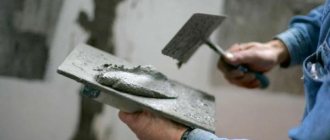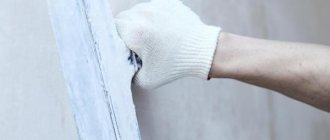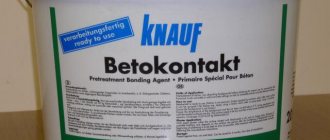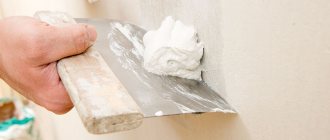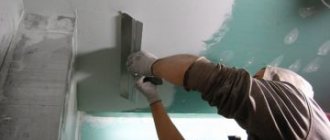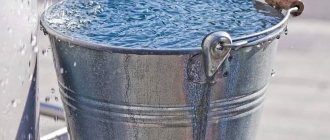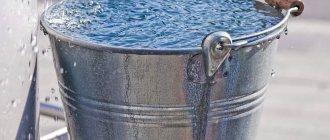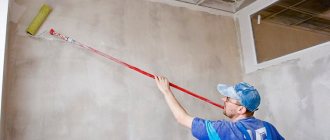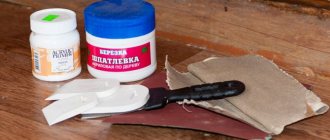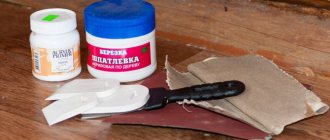Friends, we have already spoken more than once about putties that prepare walls for subsequent decoration, and we know that they differ in their basis, composition, and degree of readiness. Today I want to talk about the types of putties according to their purpose, determine the best of them, so that it is easier for you to make your choice.
Dry building mixtures - putties
The interior decoration of the walls of the house occurs in several stages. To begin with, the walls need to be leveled, since they usually have quite large visible defects, as well as differences, sometimes reaching 10-15 mm. At this stage of finishing, starting putty is used. Then a finishing putty is applied on top of the starting putty, after which the smooth and even walls can be transformed with beautiful decor.
BUY PUTTY
Start Knauf putty. Putty stages
It is very important to use high-quality mixtures from a trusted manufacturer, for example, the German company Knauf.
After applying each layer, be sure to check how evenly it lies on the wall. And you need to start with the fact that the plaster should lie flat. The thickness of the applied layer depends on what type of putty is used.
If you immediately start working not carefully and hope that by applying subsequent layers everything can be corrected, then...
Firstly, the work time will increase, because there is a minimum and maximum thickness of the putty layer, and several layers may have to be applied. After applying each layer, you must wait until it dries completely before applying the next layer.
Secondly, this will increase the consumption of putty mixture, and, accordingly, the cost of the entire repair.
After the plaster has dried, it must be treated with a primer. This will increase the adhesion of materials. The entire area of the plaster must be covered with primer, avoiding any missed spots.
The starting putty is applied when the soil is completely dry. In this case, it is advisable to use a painting net. It is applied to the wall and completely covered with putty.
Knauf start putty is applied to the plaster in a layer of no more than 5 cm. If this thickness is not enough, you need to apply one or two more layers of putty. After all the work with the base putty is completed, the finishing putty is applied. Its purpose is to create a surface ready for the application of decorating materials: wallpaper, various types of paint, any types of decorative panels.
Which brand of putty is better to choose?
The undisputed leaders among manufacturers in this ranking in terms of frequency of mention are Russian brands. Many of the manufacturers started working back in the 90s, and extensive experience is one of the keys to high quality products.
Mixtures from the following manufacturers are in high demand:
- Danogips is a Russian brand. Its first plant began operating in 2006 with the production of SuperFinish putty. Now the company's product range includes a series of more than 10 items of ready-made polymer mixtures. They are suitable for application by hand or with airless machines. Their main advantages are reduced shrinkage, smoothness of coatings, versatility of compositions suitable for processing gypsum boards, concrete, and brickwork.
- Volma is a group of companies producing finishing materials primarily based on gypsum. It was organized in 1999, and received its legal name and address in 2005. Within two years, the name “Volgograd Gypsum” was assigned to it. The majority of the line of putty finishing materials is occupied by dry mixtures, although liquid forms are also available. The manufacturer adds mineral fillers and modifying additives to their composition, which increase the resistance of coatings to cracking and improve their adhesive properties.
- Osnovit is a Russian brand offering products for repair and construction. Its products are presented in more than 60 regions of Russia. The brand's product range includes polymer, gypsum, and cement putty mixtures in the form of powder and liquid. Their advantages are durability, ease of application, economical consumption, and long service life.
- Knauf is a large manufacturer of materials for finishing walls, ceilings, and floors. It has proven itself well due to the good texture of the mixtures, beautiful color and high strength of coatings. They can be combined with drywall, concrete, and brickwork. Dry compositions are easily prepared by mixing with water and, due to their optimal density, are consumed slowly.
- Tex is a brand owned by the Finnish paint and varnish company Tikkurila and is well represented in Russia. It was registered in 1995, and its products are sold in the entry-level and mid-price range. The basis of the brand’s assortment is made up of liquid putties, ready for use. Their advantages are smooth surfaces, high quality leveling and sealing of cracks in brick and concrete walls. Some compositions can be used for outdoor work.
- Gerkules is a Russian company that dates its history back to 1997. The plant began operating in Siberia based on the experience of German manufacturers. The very first product of the company was dry construction mixtures. At the moment, it produces some of the best putties for walls, which have high ductility, making them easy to use. You can apply paint or glue wallpaper on top of the finished coatings.
- Prospectors - the company was founded in 1992 and initially positioned itself exclusively as a manufacturer of ready-made putty. Over time, its range expanded to include dry finishing materials from which an aqueous solution is prepared. They are sold in different volumes - 5, 15, 20 kg. They are characterized by good astringent properties, adhesion strength to the base, good “vitality” of the compositions, and a long shelf life (at least 12 months).
- Bergauf is a supplier of building materials with an optimal combination of price and quality. It has several large production sites. In particular, putty is produced here - gypsum, polymer, cement. Depending on the specific option, it is distinguished by frost resistance, snow-white color, compatibility with reinforced concrete surfaces, and the ability to be used in bathrooms without reducing service life.
- VGT is a large manufacturer of building materials, offering affordable putty mixtures. This is one of the few companies in the ranking that has decorative compositions for indoor and outdoor use. They are used both for partially closing cracks and for completely finishing walls and ceilings. These materials are sold in buckets, bags, tubes. There are finishing and all-purpose liquid products for creating a smooth finish.
- Optimist-Perm is a branch that began its activities in 1997. In the company's catalog you can find liquid mixtures for finishing walls and ceilings in residential and technical premises. Some of them successfully resist moisture and are used in finishing building facades. They are distinguished by their economical consumption - 0.7-2 kg/m2, while the strength of the finished coatings does not suffer. Available in 0.75, 1.5, 10 and 15 kg packaging.
The best polyurethane foams
Knauf rotband. Rotband plaster mixture Knauf technical characteristics
Universal gypsum plaster Knauf Rotband, 10kg
Leave a request for a product without registering.
The manager will contact you and place your order.
You can pay for your order in cash or by bank transfer.
Time to use the prepared solution, min:
Time to fully gain strength, h:
Minimum thickness of the applied layer, mm:
Maximum thickness of the applied layer, mm:
Universal gypsum plaster KNAUF-Rotband
Application area
KNAUF Rotband is used for high-quality plastering of ceilings and walls with a conventional solid base, for example, concrete, brick, cement plaster, as well as surfaces made of polystyrene foam, DSP.
Particularly recommended for smooth concrete ceiling and wall surfaces.
Can be used for finishing rooms with normal humidity, as well as in kitchens and bathrooms.
The use of ROTBAND plaster allows you to obtain a perfectly flat, smooth surface that does not require additional puttying
Attention! Advantages of KNAUF-Rotband!
- KNAUF-Rotband gypsum plaster provides a smooth surface that does not require additional putty.
- Rotband does not crack even with a thick layer.
- The consumption of KNAUF-Rotband gypsum plaster is 2 times less than traditional cement-sand plaster mixtures.
- Application of a plaster layer up to 50 mm thick in one stroke without preliminary spraying. If necessary, thicker layers can be applied in two coats.
- The versatility of the material allows for simultaneous plastering and puttying, production of decorative elements, repair and restoration work.
- High water-holding capacity - the mortar mixture does not separate and does not dehydrate even on porous substrates that absorb moisture well and at elevated temperatures.
- Regulates the humidity in the room - “breathes”, creating a favorable microclimate in the room.
Knauf gypsum plaster instructions. More details
Application
Dry mixture KNAUF-Rotband is intended for high-quality plastering of ceilings and walls made of concrete, brick, cement plaster, polystyrene foam surfaces, and DSP.
Recommended for smooth concrete ceiling and wall surfaces.
The plaster is suitable for finishing rooms with normal humidity, as well as in kitchens and bathrooms with a coating that provides protection against moisture.
Designed for interior work.
Advantages
- KNAUF-Rotband gypsum plaster provides a smooth surface that does not require additional putty.
- Does not crack even with a thick layer.
- The consumption of KNAUF-Rotband gypsum plaster is 2 times less than traditional cement-sand plaster mixtures.
- Application of a plaster layer up to 50 mm thick in one stroke without preliminary spraying. If necessary, thicker layers can be applied in two coats.
- The versatility of the material allows for simultaneous plastering and puttying, production of decorative elements, repair and restoration work.
- High water-holding capacity - the mortar mixture does not separate and does not dehydrate even on porous substrates that absorb moisture well and at elevated temperatures.
- Regulates the level of humidity in the room - the surface “breathes”, creating a favorable microclimate in the room.
The best decorative putties
The mixture received this name due to the possibility of giving the coating a relief to perform decorative functions. Based on the results of testing and analysis of reviews, the material presented in this rating was recognized as the best putty.
Optimist-Elite Bark beetle XL for external and internal work
This paste is purchased only for decorative purposes, which it copes with adequately thanks to its interesting texture, like bark beetle marks on tree trunks. The design can be made in absolutely any way - circular, cross, vertical, horizontal, but to make the coating aesthetically pleasing it will require some skill. If necessary, it can be painted in any color.
Putty “Bark beetle XL” from Optimist-Elite is suitable for both interior and facade work. It is distinguished by its soft white color and vapor permeability, which increases the service life of the decorative layer. It is used for all types of surfaces - concrete, brick, plastered. The mass is applied quite simply using a spatula, trowel or roller. The solution dries quickly on the base and does not pollute the space due to its not very liquid consistency.
Advantages
- Looks beautiful under a layer of varnish;
- Gives a matte finish to the surface;
- There is practically no smell;
- Does not produce evaporation;
- Environmentally friendly material.
Flaws
- Available in only one volume – a 7 kg bucket.
To achieve the desired results, the temperature in the work area should not go beyond +5-35ºC, and the maximum permissible humidity limit should be 70%.
Knauf gypsum plaster characteristics. Description and properties of Knauf gypsum plaster
Knauf gypsum plaster is made from a natural mineral of sedimentary origin. The stone settles to the bottom of lagoons and lakes, compressed under the water column from particles of bones of dead animals.
Sulfur is taken from the same organic residues or thermal springs. All that remains is to add water to the gypsum formula, the presence of which is natural in lagoons. So we get the chemical notation: - CaSO4 * 2H2O. There are no harmful elements in it.
"Knauf" is a plaster consisting of more than 95% gypsum. This makes the product environmentally friendly. The remaining 5% are polymer impurities. They correct the natural properties of aqueous calcium sulfate.
The water from it is evaporated at the powder stage. Finishers re-mix the liquid before leveling the walls and ceilings, restoring the plasticity of the plaster. The resulting mass evaporates moisture again, hardening within 20 minutes.
This limits the finishing crews' actions. You have to mix the plaster in small volumes, rushing to apply them to the walls before they lose their plasticity. Polymer additives in plaster increase the working life of some types of plaster to 40-45 minutes.
Also, additives to the gypsum mass can reduce its fluidity. This is relevant when working with fine-grained minerals. When ground, it breaks down into particles less than a millimeter in diameter.
Mixing them with water gives an excessively fluid mass. When applied to walls, it can cause sagging. It is easier to work with coarse-grained gypsum plaster. It is ground into grains with a diameter of more than a millimeter.
Gypsum plaster "Knauf" - "Rotband". The name of the line is translated from German as “Red Line” and is created by analogy with the color of a cigar band. Targeting a male audience. At the time of the creation of Knauf, gentleman builders smoked cigars en masse.
However, the name of the plaster also contains an indirect allusion to the color of the gypsum. It is rarely found in its pure form. Typically, a couple of percent of impurities are added to the 5% of polymers in the plaster.
As a result, consumers purchase gray or reddish Rotband. The latter is coarse-grained. Gray or pure white building mixtures are dust-like and more fluid.
The color of Knauf plaster is also important during finishing. The pigment in the mortar may show through thin wallpaper. If plaster is the finishing touch, it should fit into the color concept of the room. A pinkish tint is not always appropriate. Gray and white mixtures are more versatile.
Being hydrophobic, that is, a mineral that absorbs moisture, gypsum on walls can swell and be affected by fungus. Therefore, Rotband is not recommended for wet rooms.
In other rooms, offices and warehouses, Knauf plaster is durable because it has high adhesion. This is the ability of mixture particles to penetrate into adjacent surfaces. So “Rotband” reinforces them, filling the voids, and firmly adheres to the base.
Gypsum plaster is not frost-resistant. Cold rooms often have high humidity. The problem comes down to dampening of the building mixture. But it resists fire perfectly, like most stones.
How to make the right choice for plaster?
To ensure that the quality of the repair leaves no doubt, when choosing ready-made solutions, you should be guided by certain circumstances:
- the material from which the surfaces are made;
- potential operational humidity of premises;
- location of premises inside the building or outside;
- the main putty material for starting work in case the remaining layer is applied to it.
To select a putty for plaster, it is important to consider the specifics of the work that will need to be done.
Work on finishing gypsum plasterboard and gypsum fiber board includes these procedures:
- sealing seams;
- applying the remaining layer.
Due to the fact that the surface of the plasterboard sheets is already needed for applying the remaining layer, the starting layer must be used when sealing the most sensitive parts that are best susceptible to deformation. These parts are seams.
To process the seams, starting gypsum mixtures of a coarse fraction with high resistance to shrinkage and mechanical influences are used. Apply the starting layer in 2 stages using painting mesh.
Workers and specialists in repair and finishing work when finishing plasterboard partitions recommend using gypsum-based mixtures for work involving putty. And there are a number of explanations for this:
- such a mixture does not sag;
- plaster combines perfectly with plaster;
- easy to apply and level;
- dries very quickly.
Attention! When covering walls in rooms where there is high humidity, it is necessary to use moisture-resistant gypsum boards and putty with water-repellent fillers.

